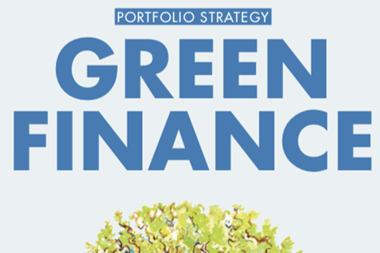The EU’s sustainability “taxonomy” could help investors reduce analysis costs and reputation risks, according to a member of the technical expert group developing the classification system.
Speaking at PensionsEurope’s annual conference last week, Brenda Kramer, responsible investment adviser at PGGM and a member of the technical expert group, told delegates that the taxonomy had been devised as a “transparency tool” and would include guidance on investing in a number of sectors.
The technical expert group on sustainable finance is set to publish its final report on the taxonomy next week, setting out criteria for sustainable economic activity.
During a panel discussion on sustainable finance, Kramer said: “More than helping pension funds classify [investments], it will help with engagement with companies. You can talk to them and help them make the transition [to a low-carbon economy].
“Secondly, it takes away a bit of the reputation risk of making a judgement call on what’s green and what’s not green by yourself… The taxonomy takes away some of the cost of analysing that, but it also takes away some of the reputation risk.”
She added that investors would not be required to invest according to the taxonomy.
“The taxonomy takes away a bit of the reputation risk of making a judgement call on what’s green and what’s not green by yourself”
Brenda Kramer, responsible investment adviser, PGGM
The taxonomy sets out which areas of industry are sustainable, and which are not, she said, including analysis of “transitional” elements of industry such as aluminium processing, concrete manufacturing and gas generation.
According to the Principles for Responsible Investment (PRI), the first industries to be covered by the taxonomy will be agriculture, manufacturing, energy, transport, water, waste, ICT and buildings.
Kramer said: “If I want to invest in energy, which energy activities are sustainable, and which are not? Wind is sustainable, but what if you invest in gas? Gas is a bit more complicated. If you combine gas plants with carbon capture and storage that could qualify.
“We’ve looked at manufacturing, we’ve looked at real estate. We’ve also looked at sectors… that are important for the transition.”
Fellow panellist Thierry Bogarty, head of ESG strategy at Amundi, supported the technical expert group’s work but warned against “normalisation” of ESG investing that could “stifle innovation”.
“ESG has been a very fast growing market for the past two or three years, and still is,” Bogarty said. “Now the time has come for a bit of standardisation, a bit of common language, but not for normalisation. That is a big difference and that is what we are cautious about.
“ESG has been market-driven for the last 10-12 years and it has been developing in a nice way. It’s good to have regulation now, but not normalisation.”
Pierre Bollon, chief executive of France’s asset management association AFG, described the taxonomy as “regulation helping us”.
‘Generational shift’: PRI backs taxonomy
The PRI has urged investors to support the sustainability taxonomy, and praised its “breadth and technical quality”.
In a blog post, Will Martindale, the PRI’s director of policy and research, described the taxonomy as a “generational shift in how investors think about impact”.
“It’s not just about the carbon saved, or the waste diverted from landfill, but whether the economic activities we finance are consistent with the future environmental state to which our governments are committed,” he said.
Martindale continued: “The EU taxonomy is a tool to bridge the gap between international sustainability goals, like the Paris climate agreement, and investment practice.
“To mobilise private finance, European policymakers understand that they need to translate climate targets into tools that investors can use…
“The taxonomy will enable [investors] to determine the proportion of revenue from sustainable economic activities financed by the investment portfolio. The taxonomy will also support active ownership efforts: investors and companies can use the taxonomy to identify future growth opportunities.
“Investors will need time to understand the taxonomy and, more time still, to integrate the taxonomy into investment practice. And investors may disagree with categorisations or thresholds. That’s okay.
“But at this first stage, we encourage investors to get behind the taxonomy, to endorse the concept and to see how they will apply the taxonomy to investment practice.”













No comments yet